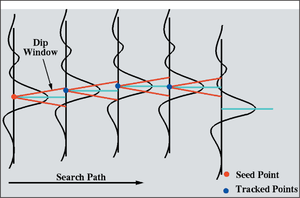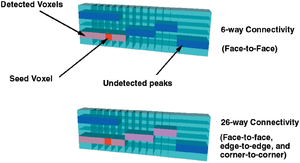Picking horizons in 3-D data
| Exploring for Oil and Gas Traps | |

| |
| Series | Treatise in Petroleum Geology |
|---|---|
| Part | Predicting the occurrence of oil and gas traps |
| Chapter | Interpreting 3-D seismic data |
| Author | Geoffrey A. Dorn |
| Link | Web page |
| Store | AAPG Store |
Computer-assisted interpretation of seismic data is one of the areas where the tools of modern interactive interpretation systems have made the most significant impact. The interpreter needs to choose the technique that will allow the best interpretation to be achieved in the most efficient manner possible. In terms of interpretive efficiency, techniques would typically be ordered in the following way, from least efficient to most efficient:
- Manual picking
- Interpolating
- Autopicking
- Surface slicing
- Voxel tracking
Manual picking
Manual picking is interpreting horizons on lines, cross-lines, time slices, and traverses by hand. This is the most familiar technique. It is also, by far, the least efficient horizon interpretation technique in terms of interpreter time and effort. While interpreting manually, the interpreter is looking for some degree of local continuity in the data and local similarity of character to identify the event to be picked.
Picking by interpolation
Interpolation is somewhat more efficient than manual interpretation. The use of interpolation, however, assumes that a horizon is locally very smooth and perhaps linear (or planar in two dimensions) between control points. If this assumption is violated between control points (e.g., there is a fault between the interpreted lines), then the results will be poor.
Autopicking

Autopicking (or autotracking) has been around in interactive interpretation systems since the early 1980s. The concept behind autopicking is quite simple. The interpreter places seed picks on lines and/or cross-lines in the 3-D survey. These seed points are then used as initial control for the autopicking operation. The algorithm looks for a similar feature on a neighboring trace. If it finds such a feature within specified constraints, it picks that trace and moves on to the next trace. Simple autopickers allow the user to specify a feature to be tracked, an allowable amplitude range, and a dip window in which to search.
Figure 1 is a sketch of how such an autopicker works. If any of the search criteria are not met (amplitude out of range, no similar feature in the dip window, etc.), the autotracker stops tracking at that trace. More sophisticated autopickers let the user specify additional criteria to control the picking.
Feature and correlation trackers
There are two classes of autopicker:
- Feature trackers
- Correlation trackers
The feature tracker searches for a similar configuration of samples within the dip window but does not perform any correlations between traces. It tries to track a configuration of samples on the seismic trace that defines a peak, trough, zero crossing, etc., from trace to trace.
A correlation tracker takes a portion of the seismic trace around the seed pick and correlates it with a neighboring trace through a set of lag times constrained by the specified dip search window. If a lag time is found with an acceptable correlation quality factor, then the pick on the new trace is accepted and the picker moves on to the next trace. Clearly, the correlation autopicker is much more computationally intensive than the feature tracker. It is also typically more robust in its picking.
Autopicker pathways
Another aspect of autopickers that must be considered is the path that the autopicker follows through the data. Many are not true volume autopickers because they track through the data only in the line or cross-line direction. In other words, the path they follow through the data is not truly three dimensional or even two dimensional. Some autopickers make consecutive passes through the data—one pass in the line direction, the next in the cross-line direction. A few autopickers actually move through the data in a true 2-D sense, expanding around control in both the line and cross-line directions in a single pass. The more sophisticated the path the autopicker follows, the more useful it will be in infilling the horizon from the interpreted seed points. The type of control the interpreter picks in the volume prior to autopicking should in part be dependent on the type of algorithm being used and the path it follows through the data.
Voxel tracking
A technique called voxel tracking has become available with the advent of volume rendering and visualization. A voxel is a volume element. In a 3-D seismic volume, it is a sample.
Voxel tracking is conceptually related to autopicking in the sense that an event or feature is tracked through the volume starting from seed control points picked by the interpreter. Voxel trackers, however, tend to follow a true 3-D path through the data. Starting at the seed voxels, the voxel tracker searches for connected voxels that satisfy the search criteria specified by the user. The search is typically conducted in line, cross-line, and time directions.
Voxel tracking assumptions

Figure 2 is a sketch of a simple voxel tracking algorithm and its behavior under two different continuity constraints. Six-way connectivity restricts the search from one voxel to only the neighboring voxels that are connected face to face. Twenty-six-way connectivity allows the search to proceed between neighboring voxels that are connected face to face, edge to edge, or corner to corner. The connectivity constraint that is used affects the outcome of the voxel tracking.
Like autopicking, voxel tracking assumes that the data are locally continuous, consistent, and connected or smooth. Both techniques assume a consistent phase is being interpreted from the data.
Voxel tracking pros and cons
Because volume-rendering techniques typically place the entire volume being visualized into RAM memory on the workstation, and since the tracking algorithm is computationally simpler than most autopickers, voxel tracking can be many orders of magnitude faster than autopicking—when it works. Most voxel tracking algorithms are more sensitive to poor signal-to-noise ratio than correlation autopickers. However, on reflections with a good signal-to-noise ratio, voxel tracking is usually the most efficient approach to picking the horizon.